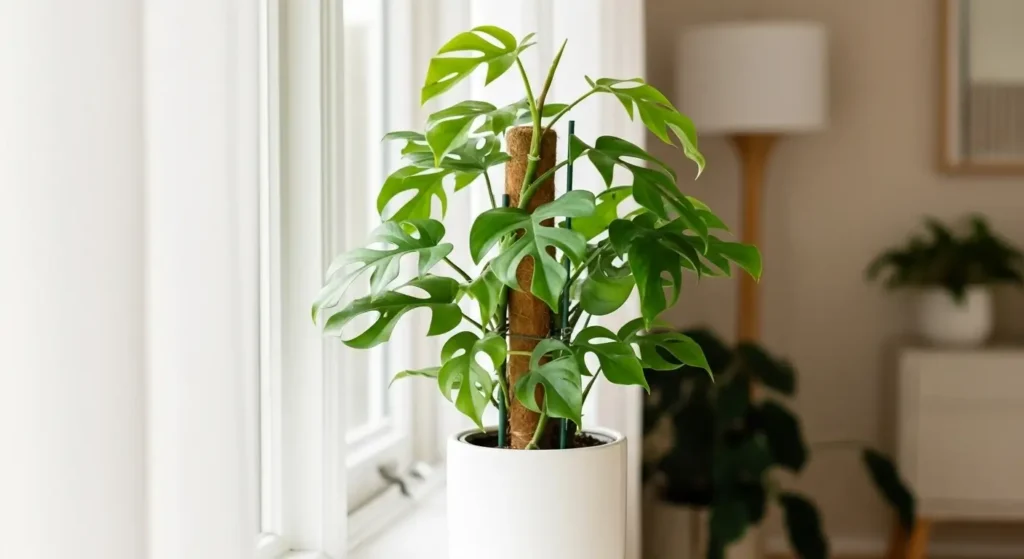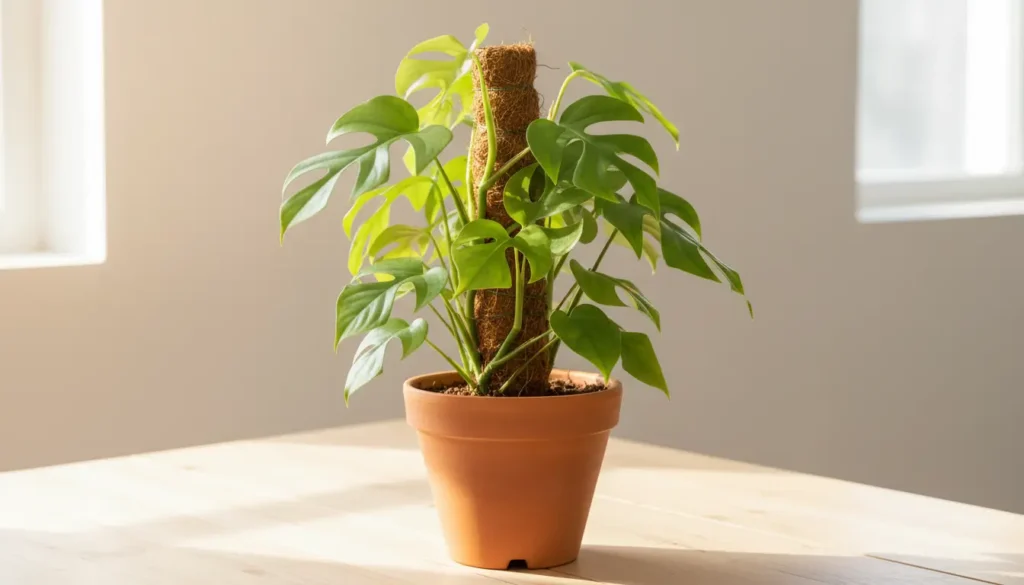
In This Article
Looking for a stunning houseplant that won’t break the bank? Meet the rhaphidophora tetrasperma, often called the mini monstera. This tropical beauty features split leaves that look like its expensive cousin, but it’s way easier on your wallet. Native to Southern Thailand and Malaysia, this fast-growing climber is perfect for beginners and experienced plant parents alike.
Honestly, if you’re after that jungle vibe without the high price tag, rhaphidophora tetrasperma is your best friend. Let’s dive into everything you need to know about keeping this gorgeous plant happy and thriving in your home.
Rhaphidophora Tetrasperma Care Card
| Care Detail | Requirements |
|---|---|
| Common Name | Mini Monstera, Ginny Philodendron |
| Botanical Name | Rhaphidophora tetrasperma |
| Family | Araceae |
| Plant Type | Perennial tropical vine |
| Mature Size | 6-12 feet indoors (can reach 15+ feet) |
| Sun Exposure | Bright indirect light |
| Soil Type | Well-draining, airy potting mix |
| Soil pH | 5.5-7.0 |
| Hardiness Zones | 10-12 (indoor plant in most areas) |
| Native Area | Southern Thailand, Malaysia |
| Toxicity | Toxic to pets and humans |
Rhaphidophora Tetrasperma Care
This plant is considered easy to moderate for care, making it perfect for those new to tropical houseplants. In the following sections, we’ll cover everything from light and water to propagation and troubleshooting. You’ll love how forgiving this fast grower can be!
Light
Rhaphidophora tetrasperma thrives in bright, indirect light. Think of the dappled sunlight it would get under a rainforest canopy in its native habitat. Place it near an east or west-facing window where it gets plenty of brightness without harsh direct sun.
Too much direct sunlight will scorch those beautiful split leaves, turning them yellow or brown. On the flip side, insufficient light causes leggy growth and smaller leaves without the characteristic splits. According to University of Missouri Extension, most foliage plants do well with light at a north window or sunlight diffused through a lightweight curtain. If your plant starts looking stretched out, move it closer to your light source.
Soil
Your rhaphidophora tetrasperma needs a well-draining potting mix that holds some moisture while allowing excess water to escape. According to Penn State Extension, proper drainage is key to preventing root rot in container plants. A chunky, airy mix works best for this tropical climber.
Try mixing 2 parts potting soil, 1 part perlite, and 1 part orchid bark. This combination provides the perfect balance of moisture retention and drainage that keeps roots healthy and happy.
Water
Water your rhaphidophora tetrasperma when the top 2-3 inches of soil feel dry to the touch. Stick your finger in the soil to check before watering. When you do water, give it a good soak until water drains from the bottom of the pot.
Overwatering causes yellowing leaves and root rot, while underwatering leads to crispy brown edges and drooping foliage. The key is consistency without going overboard. Similar watering needs apply to philodendron brasil, another beginner-friendly tropical plant.
During spring and summer, you’ll water more frequently as the plant actively grows. In fall and winter, dial it back since growth slows down and the soil stays moist longer.
Temperature and Humidity
Keep your mini monstera in temperatures between 60-80°F. It’s pretty adaptable to typical household conditions, which makes it such a great indoor plant. However, it prefers humidity levels above 50% for optimal growth.
Avoid placing it near cold drafts, air conditioning vents, or heating registers. Sudden temperature changes stress the plant and can cause leaf damage. If your home is dry, especially in winter, consider using a humidifier or placing the pot on a pebble tray with water.
Fertilizer
Feed your rhaphidophora tetrasperma with a balanced liquid fertilizer every 2-4 weeks during spring and summer. According to University of Maryland Extension, a standard 20-20-20 formula works perfectly for this fast-growing vine.
Reduce fertilizing in fall and stop completely in winter when growth naturally slows. Too much fertilizer causes salt buildup in the soil, which can damage roots.
Propagating Rhaphidophora Tetrasperma

The best time to propagate is during spring and summer when the plant is actively growing. This plant roots incredibly easily, making it perfect for sharing with friends or expanding your collection.
Propagating by Stem Cuttings
This is hands-down the easiest method for multiplying your mini monstera. You’ll have new plants growing in no time.
Materials needed:
- Clean, sharp scissors or pruning shears
- Small pot with drainage holes
- Well-draining potting mix or a jar of water
- Rooting hormone (optional)
Step 1: Choose a healthy stem with at least one node and one or two leaves. The node is the bump where leaves emerge from the stem.
Step 2: Make a clean cut just below a node, ensuring your cutting is 4-6 inches long with at least one aerial root if possible.
Step 3: Place the cutting in water or directly into moist potting soil. If using water, change it every few days to keep it fresh.
Step 4: Keep the cutting in bright, indirect light and maintain consistent moisture. You’ll see roots developing in 2-3 weeks, and it’s ready to pot up once roots are 2-3 inches long.
Just like with neon pothos, these cuttings root fast and rarely fail.
Potting and Repotting Rhaphidophora Tetrasperma

Repot your rhaphidophora tetrasperma every 1-2 years or when it becomes rootbound. Signs include roots growing through drainage holes, water running straight through the pot, or slowed growth despite good care.
Choose a pot that’s 1-2 inches larger in diameter than the current one. Don’t go too big at once, as excess soil can hold too much moisture and lead to root rot. Make sure your new pot has drainage holes at the bottom.
Gently remove the plant from its current pot, loosen the roots slightly, and place it in the new container with fresh potting mix. Water thoroughly after repotting and avoid fertilizing for about a month to let the roots settle.
Common Pests and Diseases
Like most houseplants, rhaphidophora tetrasperma can occasionally attract pests, especially when stressed or kept in poor conditions. According to Oklahoma State University Extension, using integrated pest management techniques helps prevent problems before they occur. Regular inspection helps catch issues early before they become serious.
Spider Mites
Look for tiny webs between leaves and stippling on foliage that appears as tiny yellow dots. Treat with insecticidal soap or neem oil, wiping down leaves thoroughly every few days until the infestation clears.
Mealybugs
These white, cottony pests hide in leaf axils and along stems. Remove them with a cotton swab dipped in rubbing alcohol, then spray the plant with neem oil for thorough treatment.
Scale Insects
Scale appears as small brown or tan bumps stuck to stems and leaves. Scrape them off gently with your fingernail or a soft brush, then treat the entire plant with horticultural oil or neem spray.
Aphids
These tiny green or black insects cluster on new growth and under leaves. Spray them off with water or treat with insecticidal soap for persistent infestations that weaken your plant.
Common Problems with Rhaphidophora Tetrasperma
Here’s how to troubleshoot common issues:
Yellow Leaves
This is usually a sign of overwatering, especially if leaves turn yellow and feel soft or mushy. Let the soil dry out more between waterings and check that your pot has proper drainage.
Nutrient deficiency can also cause yellowing, particularly older lower leaves. According to Iowa State University Extension, feeding regularly during the growing season prevents nutrient-related yellowing. Natural aging causes some yellowing too, and it’s totally normal to lose a few older leaves occasionally. Just like with spider plant, yellowing happens for multiple reasons, so check your watering habits first.
Brown Leaves
Brown, crispy leaf tips usually mean low humidity or poor water quality. Increase humidity around your plant with a humidifier or pebble tray filled with water.
Tap water containing fluoride or chlorine can cause browning too. Switch to filtered or distilled water if this is an ongoing issue. Underwatering also causes brown, crispy edges that spread inward, so check soil moisture regularly.
Drooping or Wilting Leaves
Underwatering is the most common cause of drooping foliage. Give your plant a thorough watering and it should perk up within hours. However, overwatering can also cause wilting if roots are damaged and rotting.
Check the soil and adjust your watering schedule accordingly. Similar issues occur with philodendron micans when watering gets inconsistent, so find that sweet spot for your plant.
Leggy Growth
Insufficient light causes your rhaphidophora tetrasperma to stretch toward the light source, resulting in long stems with sparse foliage and small leaves. Move your plant to a brighter location with more indirect light throughout the day. Prune back leggy stems to encourage bushier growth from lower nodes.
FAQ
Is a mini monstera really a monstera?
No, mini monstera (Rhaphidophora tetrasperma) isn’t a true Monstera. It belongs to the Rhaphidophora genus but resembles Monstera deliciosa with its fenestrated leaves.
Is Rhaphidophora tetrasperma easy to care for?
Yes, Rhaphidophora tetrasperma is beginner-friendly. It tolerates various light conditions, grows quickly, and requires only basic care: moderate watering, indirect light, and occasional fertilizing.
What is the difference between monstera and Rhaphidophora?
Monstera and Rhaphidophora are different genera. Monstera has larger leaves with holes and splits, while Rhaphidophora tetrasperma has smaller leaves with splits only.
Do mini monsteras climb or hang?
Mini monsteras naturally climb using aerial roots. They prefer climbing on moss poles or trellises but can trail if unsupported, though climbing encourages larger leaves.
